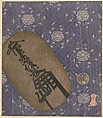Ōban gold coin and mameita-gin silver “bean coin” against peony-motif decorated paper
Watanabe Kazan Japanese
Not on view
The first poem, with its mention of badai (horse payments), no doubt inspired the imagery in this print. It was a time-honored tradition to make a gift offering of a horse to a Shinto shrine, but for centuries it was also the custom to make a monetary payment—equal to the value of a fine horse. The ohiroma mentioned in the verse suggests that the setting is the reception room of a daimyo’s residence. A “large horse payment” (ō-badai) would be paid in gold, and a “small horse payment” (ko-badai) in silver. Also, the depiction of a ten-ryō coin on a print devoted to equine themes recalls the story of Chiyo, the wife of Yamauchi Kazutoyo(one of Oda Nobunaga’s generals) who skimped and saved—wearing robes patched with old cloth—to raise ten ryō to acquire a fine horse for her husband, which he rode into many military victories.
The second poem is by Kyōkado, another pen name used by Yomo no Magao, whose verse also appears on another print that Kazan produced for 1829, year of the ox. The poem complements the image of “gold” by using the phrase “mountains where golden flowers bloom” (kogane hana saku yama), which is borrowed verbatim from a poem in the ancient poetry anthology Man’yōshū to refer to Michinoku, northern Japan. Colts raised in Michinoku were celebrated for their fine color, strength, and mettle.
The poems can be deciphered and translated as follows:
愚連堂凹
御広間も庭も霞のたち馬代
春と披露の鶯の声
Ohiroma mo
niwa mo kasumi no
tachi badai
haru to hirō no
uguisu no koe
In the reception room
and garden as mist rolls in,
the year’s “horse payments”
for this spring are announced
by the warbler’s song.
—Gurendō Nakakubo
狂歌堂
はつ夢にみちのく立の駒なへて
黄金花咲山に遊へり
hatsuyume ni
Michinoku-dachi no
koma nabete
kogane hana saku
yama ni asoberi
In the year’s first dream,
colts from Michinoku
gambol and frolic
together in the mountains
where golden flowers bloom.
—Kyōkadō
(Trans. John T. Carpenter)
Artist’s seal: Kazan in a fundō (copper counterweight) shaped seal
Shikishiban surimono
Due to rights restrictions, this image cannot be enlarged, viewed at full screen, or downloaded.

